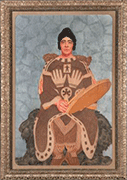Museum archives unravel art enigma
April 9, 2015
A drawing of an unidentified woman dressed in 19th century Inuit clothing posed an enigma to the art dealer entrusted with selling the portrait. But when the dealer showed the 1927 Langdon Kihn rendering to experts at the Canadian Museum of History, they immediately recognized the woman in the portrait and pieced together the story of why Juliette Gaultier de la Vérendrye — a classically trained Canadian soprano — was pictured wearing the coat of an Igloolik shaman.
“We found a letter she wrote in February 1927 saying ‘Kihn is making my portrait in Eskimo attire,’” says Judith Klassen, the Museum of History’s Curator for Cultural Expression. “The timing fits, the clothing fits. Through the material in our archives, we were able to put it all together.”
The story behind the picture
The coat belonged to a shaman named Qingailitaq (or Qingailisaq). The shaman sold it around 1902 to a whaling captain, who in turn donated it to the American Museum of Natural History in New York. (A reconstruction of the coat, created in the 1980s by Igloolik community members, resides in the National Collection at the Canadian Museum of History.)
In 1927, Gaultier was living in New York, preparing for her April debut at the Town Hall Theater. Gaultier specialized in what she called “Canadian folk songs,” which included the music of Inuit and First Nations communities. Striving for authenticity in her performances, Gaultier studied transcriptions of the songs and read the field notes of Marius Barbeau and Diamond Jenness, anthropologists at the National Museum of Canada (now the Canadian Museum of History). Jenness also loaned Gaultier clothing associated with Indigenous peoples from Museum collections for her Canadian performances.
For Gaultier’s New York debut, Langdon Kihn, known for his portraits of Native Americans, was commissioned to paint the stage set. Gaultier, who borrowed a cedar bark cape from the American Museum of Natural History to wear during her performance, must have also convinced the same museum to lend her the shaman’s coat for the Kihn portrait.
The changing role of the Museum
While this sort of loan does not occur today, and was unusual even in its time, the portrait of Gaultier embodies an important piece of Canadian cultural history.
“This drawing seems to meaningfully shed light on the connection between history, populism, culture and the place of the National Museum at that time,” says Klassen. “It’s not simple. It challenges people to think.”
To learn more about Juliette Gaultier de La Vérendrye, visit the Museum’s blog.
Image: Juliette Gaultier de la Vérendrye, by Langdon Kihn Canadian Museum of History, photo Steven Darby, IMG2015-0023-0001-Dm